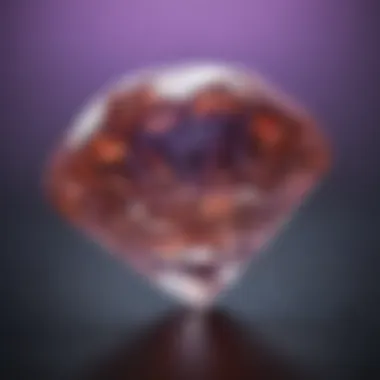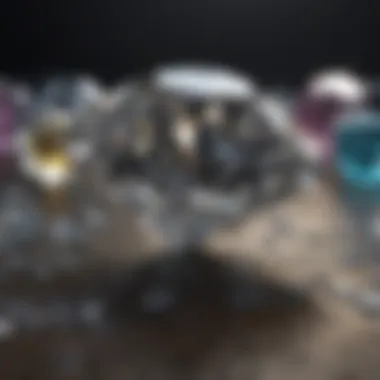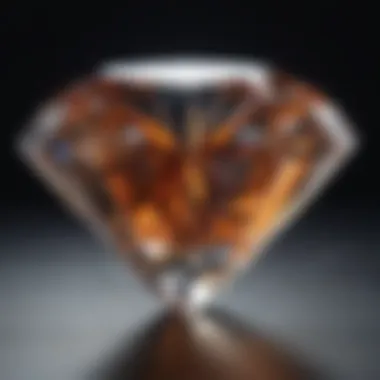Unveiling the Intricate Process of Determining Diamond Worth


Overview of Gemstones and Minerals
Gemstones and minerals have captivated human fascination for centuries, with their allure and rarity symbolizing wealth, beauty, and sophistication. The history of using gemstones and minerals dates back to ancient civilizations, where these precious stones held spiritual, healing, and decorative significance. From the opulence of royal crowns to the everyday jewelry worn by commoners, gemstones have played a vital role in various cultures and societies throughout history.
Gemstone Formation and Properties
The formation process of gemstones is a fascinating journey that unfolds deep within the Earth's crust where intense heat and pressure transform rocks and minerals into exquisite crystals. These gemstones possess distinct properties that set them apart, such as clarity, color, carat weight, and cut. Gems are classified based on their unique attributes like color intensity, hardness on the Mohs scale, and luster ranging from dull to brilliant, each contributing to their individuality and value.
Types of Gemstones
From precious to semi-precious categories, gemstones are categorized based on their rarity, beauty, and demand in the market. The distinction between these types lies in their availability and desirability, with diamonds, rubies, sapphires, and emeralds classified as precious, while amethyst, topaz, and aquamarine belong to the semi-precious group. Additionally, there are common gemstone varieties like garnet, tourmaline, and peridot, as well as exotic and rare specimens such as alexandrite, tanzanite, and jadeite, each cherished for their uniqueness.
Identifying and Evaluating Gemstones
The value of a gemstone is determined by various factors, including its cut, color, clarity, and carat weight, commonly known as the 4Cs. Gemologists utilize specialized techniques like magnification and color meters to identify gemstones accurately, considering their optical properties and inclusions. Assessing gemstone quality involves examining for imperfections, determining rarity, and evaluating market demand, all of which contribute to the overall value and desirability in the gemstone industry.
Caring for Gemstones
Proper care and maintenance are crucial to preserve the beauty and longevity of gemstones. Cleaning gemstones with gentle solutions and storing them away from harsh chemicals or extreme temperatures can help maintain their brilliance and luster over time. Avoiding common mistakes in gemstone care, such as exposure to direct sunlight or abrasive materials, can prevent damage and ensure the stones retain their value. Tailoring preservation techniques to specific gem types, like pearls, opals, or turquoise, is essential for safeguarding their natural splendor and charm.
Understanding Diamond Value
In the realm of gemology, understanding the value assigned to diamonds is a nuanced and intricate matter that requires keen attention to detail and a thorough grasp of the contributing factors. This section serves as the foundation for the entire article, where we dissect the multifaceted nature of diamond valuation. Delving into the 4Cs - Carat Weight, Cut Quality, Color Grade, and Clarity Grade - we uncover the significance of each element in determining the worth of these prized gemstones. By exploring the interplay between these aspects and additional influential factors, such as diamond shape, fluorescence, certification, and market demand, we aim to provide a holistic view of what drives the value of diamonds in the market landscape. Thus, for gem enthusiasts and curious minds alike, this section offers a crucial introduction to the intricate world of diamond assessment.
The 4Cs of Diamonds
Carat Weight
In the evaluation of a diamond, carat weight reigns as a pivotal component, directly impacting the overall value and allure of the gemstone. Carat weight, representing the measure of a diamond's mass, carries significant weight in determining its rarity and pricing. The choice of carat weight can influence a diamond's desirability, with larger carat stones often garnering more attention and commanding higher prices. However, it's essential to note that while a higher carat weight may seem appealing, it can also amplify the inclusion visibility, potentially affecting the stone's clarity. Understanding the delicate balance between carat weight and other 4Cs is imperative for individuals navigating the diamond market.


Cut Quality
When it comes to diamond assessment, cut quality emerges as a critical factor that significantly contributes to the gemstone's overall appeal. The cut of a diamond dictates its brilliance, fire, and scintillation, making it a sought-after characteristic for those seeking a dazzling and radiant gem. Optimal cut proportions ensure light reflection and refraction within the stone, enhancing its visual beauty. However, any deviation from the ideal cut grades can diminish the diamond's sparkle and value. Thus, grasping the nuances of cut quality and its implications on diamond worth is essential for those venturing into the world of gem appreciation.
Color Grade
Considered one of the 4Cs, the color grade of a diamond holds substantial importance in assessing its beauty and value. Diamonds exist in a spectrum of colors ranging from colorless to various shades of yellow and brown. The color grade determines the presence of any tint within the stone, with higher grade diamonds exhibiting exceptional purity and transparency. Colorless diamonds, graded at the top of the scale, are highly coveted for their rarity and brilliance. Conversely, colored diamonds, with distinct hues like blue, pink, or yellow, showcase individuality and allure. Understanding the significance of color grades aids in discerning the subtle variations that impact a diamond's visual appeal and market worth.
Clarity Grade
As a fundamental aspect of diamond evaluation, clarity grade plays a vital role in ascertaining the internal characteristics of a gemstone. Clarity grade assesses the presence of imperfections, or inclusions, within the diamond, affecting its transparency and brilliance. Diamonds with higher clarity grades are valued for their pristine clarity and unobstructed light performance. However, flawless diamonds are rare and command a premium in the market. It's essential to comprehend how clarity grades influence a diamond's visual appearance and overall desirability when exploring the complex landscape of diamond valuation.
Evaluating Diamond Worth
Diamond worth evaluation is a crucial aspect of this article as it delves deep into the multifaceted elements that determine the value of these exquisite gemstones. Understanding the worth of a diamond involves a meticulous examination of various factors, ranging from the traditional 4Cs (Carat Weight, Cut Quality, Color Grade, and Clarity Grade) to the impact of market trends and rarity on pricing. By scrutinizing these elements, individuals can make informed decisions when it comes to purchasing, selling, or investing in diamonds.
Professional Appraisals
Role of Gemologist
The role of a gemologist plays a pivotal part in diamond valuation. Gemologists are experts trained in the identification and assessment of gemstones, including diamonds. Their keen eye and extensive knowledge enable them to evaluate factors such as color, clarity, and cut quality, providing valuable insights into a diamond's overall quality. By relying on a gemologist's expertise, individuals can gain confidence in the authenticity and value of their diamonds, making it a preferred choice for this article. Despite the reliance on subjective judgments, gemologists bring a level of credibility and precision to the appraisal process that is unmatched by other means.
Appraisal Process
The diamond appraisal process is a systematic method for determining the monetary value of a diamond. It involves a comprehensive assessment of the diamond's physical characteristics, quality, and rarity to arrive at an accurate valuation. The process typically includes inspections of the 4Cs, as well as considerations of market demand and trends. By following standardized appraisal procedures, individuals can ensure transparency and accuracy in evaluating diamond worth. While the process may be time-consuming, it is essential for making informed decisions regarding diamond transactions.
Appraisal Certificate
An appraisal certificate is a written document that details the specifics of a diamond's evaluation. It serves as an official record of the diamond's quality, providing information on its 4Cs, measurements, and any distinguishing features. The certificate also includes the appraiser's credentials and signature, adding an extra layer of legitimacy to the appraisal. Possessing an appraisal certificate increases the credibility of a diamond's value and authenticity, making it a valuable tool for buyers, sellers, and investors in the diamond market.
Market Trends and Diamond Pricing


In the vast universe of diamond valuation, understanding market trends and pricing dynamics holds a pivotal role that cannot be understated. Market trends are the compass that guides investors and enthusiasts alike in navigating the ever-evolving landscape of diamond worth. By delving deep into market trends and diamond pricing, individuals can glean priceless insights into the forces shaping the value of these treasured gemstones. Keeping a keen eye on market trends empowers stakeholders to make informed decisions, capitalizing on emerging opportunities while mitigating risks associated with volatile market conditions. The significance of market trends and diamond pricing is magnified when considering the nuanced interplay between supply and demand, global economic shifts, and consumer preferences. Observing market trends allows gem enthusiasts to anticipate price fluctuations, identify investment prospects, and stay abreast of industry developments. In this article, we shed light on the multifaceted nature of market trends and its profound impact on diamond pricing, offering a comprehensive analysis that transcends surface-level observations.
Global Diamond Market Analysis
Industry Insights
Unraveling the layers of the diamond industry, industry insights provide a panoramic view of the market forces at play. Understanding industry insights is akin to deciphering the DNA of the diamond trade, unraveling the intricacies that govern pricing mechanisms, distribution channels, and consumer behavior. Industry insights serve as a compass for discerning investors, offering invaluable data on market trends, production volumes, and emerging consumer markets. Exploring industry insights in this article immerses readers in the heartbeat of the diamond industry, providing a nuanced understanding of the factors that shape diamond valuations.
Price Fluctuations
Navigating the turbulent waters of price fluctuations in the diamond market requires a keen understanding of the underlying dynamics driving these shifts. Price fluctuations stem from a myriad of factors, including changes in consumer demand, geopolitical events, and technological advancements impacting mining operations. Analyzing price fluctuations unveils patterns that illuminate the cyclical nature of diamond pricing, offering investors and industry players insights into opportune moments for buying or selling. Our deep dive into price fluctuations elucidates the complexities inherent in diamond valuation, highlighting the importance of foresight and analytical acumen in navigating this dynamic market landscape.
Impact of Rarity on Diamond Value
Limited Editions
The allure of limited editions in the realm of diamond valuation lies in their exclusivity and scarcity, driving demand from collectors and connoisseurs alike. Limited editions encapsulate the essence of rarity, embodying a bespoke charm that sets them apart from mass-produced counterparts. Discerning investors recognize the unique appeal of limited editions, viewing them not just as adornments but as enduring investments with the potential to appreciate significantly over time. Our exploration of limited editions sheds light on the intricate dance between rarity and value in the diamond market, unveiling the mystique that surrounds these exceptional gemstones.
Colored Diamonds
Drenched in a spectrum of hues, colored diamonds captivate the imagination with their diverse palette and mesmerizing beauty. The allure of colored diamonds lies not just in their vibrant aesthetics but also in their rarity and unique geological formations. From vivid yellows to deep blues, each colored diamond tells a story of geological marvel, making them coveted treasures for collectors and investors seeking distinctive assets. Our in-depth analysis of colored diamonds uncovers the fascinating interplay between rarity, color intensity, and market demand, providing a comprehensive overview of this captivating segment within the diamond industry.
Investing in Diamonds
Investing in Diamonds is a critical segment of this article due to its profound significance in the realm of precious gemstones. Diamonds hold a unique position as financial assets, offering investors a haven for portfolio diversification and potential resale opportunities. The allure of diamonds as an investment is driven by their enduring value and ability to act as a hedge against market volatility. For gemstone enthusiasts seeking to broaden their investment portfolio, diamonds present a tangible and captivating option.
Diamonds as Financial Assets
Portfolio Diversification
Portfolio diversification stands out as a pivotal strategy for investors looking to mitigate risk and maximize returns. Within the context of diamond investments, portfolio diversification entails allocating a portion of funds towards acquiring diamonds alongside other traditional assets such as stocks and bonds. This diversification strategy aims to spread risk across different asset classes, reducing the impact of market fluctuations on the overall portfolio's performance. Diamonds, with their intrinsic value and relatively stable market, provide a valuable component to a well-rounded investment portfolio. Despite the illiquid nature of diamonds, their lack of correlation with traditional markets contributes to enhancing portfolio stability.


Resale Potential
Exploring the resale potential of diamonds unveils another layer of their investment appeal. Diamonds possess inherent resale value, making them a sought-after commodity in the secondary market. Investors can leverage the enduring desirability and scarcity of diamonds to realize profits upon resale. The resale potential of diamonds is influenced by factors such as carat weight, cut quality, and market demand, underscoring the importance of acquiring high-quality stones. However, challenges may arise concerning verifying diamond authenticity and market fluctuations, impacting the resale process. Despite these nuances, strategically navigating the resale market can yield lucrative returns for shrewd investors.
Risk Factors in Diamond Investments
Market Volatity
Market volatility poses a significant consideration for individuals engaging in diamond investments. The diamond market, while relatively stable, is not immune to price fluctuations influenced by various factors such as global economic conditions, consumer trends, and supply chain disruptions. The volatility inherent in diamond pricing necessitates careful risk assessment and strategic decision-making to navigate market uncertainties effectively. Investors must stay informed about industry trends, engage in thorough market research, and exercise prudence in their investment strategies to mitigate potential losses arising from market volatility.
Authenticity Cenrerns
Authenticity concerns represent a critical risk factor within the diamond investment landscape. Ensuring the authenticity and provenance of diamonds is paramount to maintaining their value and safeguarding against fraudulent practices. The proliferation of synthetic diamonds and potential discrepancies in certification processes heighten concerns surrounding authenticity in the diamond market. Investors must exercise due diligence in verifying diamond credentials, relying on reputable certification bodies and industry experts to validate the authenticity of purchased stones. By addressing authenticity concerns proactively, investors can uphold the integrity of their diamond investments and minimize the risk of encountering fraudulent schemes.
Ethical Considerations in Diamond Valuation
In the realm of gemology and jewelry, ethical considerations hold paramount significance, shaping not only the value of diamonds but also the ethical compass of the industry as a whole. Addressing the ethical side of diamond valuation is crucial for ensuring transparency, sustainability, and social responsibility. By scrutinizing the origins of diamonds and the practices involved in their extraction and trade, ethical considerations aim to mitigate the negative impacts associated with mining and trafficking of these precious stones. Moreover, in an era where consumers are increasingly conscientious about the ethical implications of their purchases, incorporating ethical considerations in diamond valuation is not just a choice but a necessity to uphold ethical standards and meet the evolving expectations of stakeholders.
Conflict-Free Diamonds
Certifications
Certifications play a pivotal role in guaranteeing the conflict-free status of diamonds, assuring buyers that the gems they acquire have been sourced ethically and with due diligence. The key characteristic of certifications lies in their ability to provide a verifiable record of a diamond's journey from the mine to the market, highlighting its conflict-free nature. This transparency not only instills confidence in buyers but also aligns with the ethical principles advocated in this article. The unique feature of certifications is their capacity to trace the diamond's provenance, ensuring that it has not been linked to unethical practices or human rights violations. While certifications add a layer of assurance and credibility to diamond valuation, they may also involve additional costs and bureaucratic procedures, balancing the need for transparency with practical considerations.
Ethical Sourcing Practices
Ethical sourcing practices represent a conscious effort to procure diamonds responsibly, considering the social and environmental impact of mining activities. The key characteristic of ethical sourcing practices is their commitment to promoting fair labor conditions, minimizing ecological footprint, and supporting local communities where diamonds are mined. In the context of this article, ethical sourcing practices emerge as a beneficial choice due to their alignment with ethical considerations in diamond valuation. The unique feature of ethical sourcing practices lies in their emphasis on creating positive social outcomes and environmental stewardship, contributing to a more sustainable and equitable diamond industry. While ethical sourcing practices enhance the ethical integrity of diamonds, they may present logistical challenges and entail higher costs, underscoring the complexities of ethical sourcing in the diamond trade.
Sustainability and Social Impact
Community Development
Community development initiatives associated with diamond mining play a pivotal role in fostering socio-economic progress in mining regions. The key characteristic of community development lies in its focus on empowering local communities through education, healthcare, infrastructure development, and economic opportunities. In the context of this article, community development stands out as a popular choice due to its potential to create lasting and positive impacts on the livelihoods of those residing in diamond-producing areas. The unique feature of community development is its capacity to enhance social cohesion, reduce poverty, and promote sustainable development, aligning with the broader goals of ethical diamond valuation. While community development projects bring about tangible benefits, they require long-term commitment, strategic planning, and collaboration with local stakeholders to ensure meaningful transformation.
Environmental Conservation
Environmental conservation efforts in the diamond industry aim to mitigate the ecological impact of mining activities, safeguard natural habitats, and preserve biodiversity. The key characteristic of environmental conservation is its focus on implementing responsible environmental practices, such as land reclamation, water management, and wildlife protection, to minimize the environmental footprint of diamond mining operations. In the context of this article, environmental conservation emerges as a beneficial choice given its role in promoting ecological sustainability and mitigating environmental degradation associated with diamond extraction. The unique feature of environmental conservation lies in its potential to balance resource extraction with environmental protection, demonstrating a commitment to sustainable practices within the diamond sector. While environmental conservation initiatives yield positive outcomes for ecosystems and communities, they necessitate innovative technologies, regulatory compliance, and ongoing monitoring to ensure environmental stewardship and conservation of natural resources.







